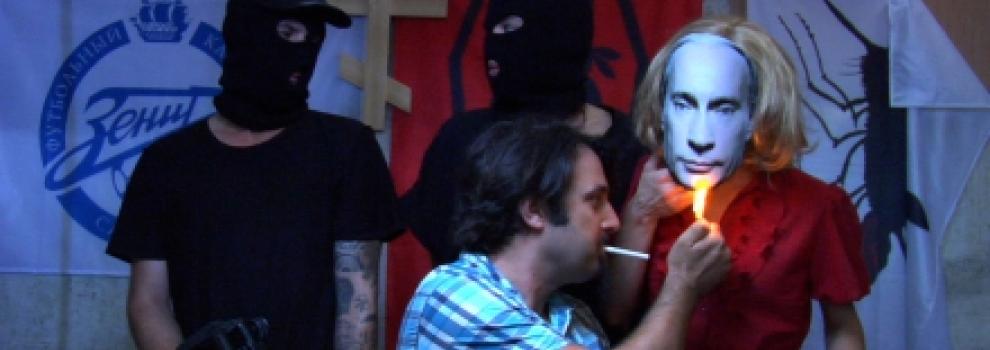
‘The Buried Alive Videos & Tse (Out)’
Past event
Cancelled
Postponed
22 Feb.'15
- 00:00
Audiences
In deIn the context of a Sunday with Roee Rosen
The Buried Alive Videos is part of a trans-media project centered on the figure the fictive Russian poet and artist Maxim Komar-Myshkin, a paranoiac whose last work attempted to do battle with Vladimir Putin. Upon his immigration to Tel Aviv, Komar-Myshkin founded “The Buried Alive Group”, a tightly knit collective of ex-soviet artists, performers, musicians and writers. As their name attests, they perceived themselves as cultural zombies. Buried Alive were resolutely alienated from the local Israeli cultural scene towards which they felt inherently superior, yet they were also experiencing the tremendous hardship and insecurity stemming from their seclusion. Their isolation also echoes former Russian avant-garde groups, whose artistic activity was secret and clandestine, such as the Ouberio group in the 30s, and the “unofficial artists” working in Moscow in the 60s-80s. The Buried Alive Videos compiles 6 works supposedly produced by the group between 2004-2010, and brackets them with sections from the Buried Alive Manifesto (2004), which sets the creative and ideological guidelines of the group. These videos, first presented at the Bergen Assembly as an installation of texts and videos, can also be viewed separately. These works include chants geared to breathe life into commodities, jokes from the history of Russia recited by venerated kidnapping victims, and an attempt to kill a young artist by means of a voodoo-doll, realized as two silent and synchronized one-shots.
Out presents a domination/ submission scene set in a mundane living room. The increasing pain prompts the sub to spew out not only cries of pleasure and pain, but also sentences. The scene thus connotes both confessions under torture, and rituals of exorcism, even as it remains a documentation of wilful pleasure, being that both participants are not actresses, but members of the Israeli BDSM community. The demon who speaks through the sub, is and isn’t herself. In fact, the sentences are all quotes of Israel’s minister of foreign affairs, Avigdor Lieberman, one of the most extreme right wing politicians in Israel. The ritual is framed by two scenes. A preceding interview with the two participants seems at the beginning to be a straightforward documentary, but transforms into an exposition of the narrative premise by which one is possessed, the other an exorcist. The final musical scene is a song set to the words of the Russian poet Esenin’s Letter to Mother. Executed as a one-shot, the song is a direct, if twisted, homage to the final scene of another film that deals with radical sexuality and politics: Dusan Makavejev’s W.R. - The Mysteries of the Organism.
Out presents a domination/ submission scene set in a mundane living room. The increasing pain prompts the sub to spew out not only cries of pleasure and pain, but also sentences. The scene thus connotes both confessions under torture, and rituals of exorcism, even as it remains a documentation of wilful pleasure, being that both participants are not actresses, but members of the Israeli BDSM community. The demon who speaks through the sub, is and isn’t herself. In fact, the sentences are all quotes of Israel’s minister of foreign affairs, Avigdor Lieberman, one of the most extreme right wing politicians in Israel. The ritual is framed by two scenes. A preceding interview with the two participants seems at the beginning to be a straightforward documentary, but transforms into an exposition of the narrative premise by which one is possessed, the other an exorcist. The final musical scene is a song set to the words of the Russian poet Esenin’s Letter to Mother. Executed as a one-shot, the song is a direct, if twisted, homage to the final scene of another film that deals with radical sexuality and politics: Dusan Makavejev’s W.R. - The Mysteries of the Organism.
Practical information
Dates
Language
- Subtitles: English
